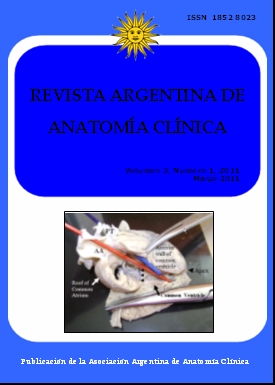STUDY OF INTERCONDYLOID FORAMEN OF HUMERUS. Estudio del foramen intercondíleo del húmero
DOI:
https://doi.org/10.31051/1852.8023.v3.n1.13911Palabras clave:
Supratrochlear foramen, septum, humerus, medial epicondyle, agujero supratroclear, húmero, epicóndilo medialResumen
Una delgada lámina ósea entre el olécranon y la fosa coronoides es a veces perforada para formar un agujero denominado foramen supratroclear (STF). Dado que el agujero se encuentra entre el epicóndilo lateral y el medial, también se llama el agujero intercondiloidea. Este agujero fue más frecuente en los huesos prehistóricos. El agujero se ha estudiado en detalle en 214 húmeros secos (131 lado derecho y 83 lado izquierdo) de sexo y edad desconocidos. De 214 huesos, el agujero estaba presente en 67 húmeros (48 lado derecho y 19 lado izquierdo) que muestra una incidencia del 31,3%. El diámetro transversal medio fue de6,5 mma la derecha y5,8 mma la izquierda. El diámetro vertical promedio fue de4,4 mma la derecha y3,9 mmen el lado izquierdo. La distancia media del STF desde la punta del epicóndilo fue de 24,4mm a la derecha y de24,5 mmen el lado izquierdo. Algunos de los huesos mostraron translucidez del tabique óseo (49,3% y 35,9% a la derecha e izquierda, respectivamente). En las radiografías simples, el agujero puede simular una lesión osteolítica. El conocimiento anatómico de STF puede ser beneficioso para los antropólogos, los cirujanos ortopedistas, los radiólogos y en la práctica clínica diaria.
A thin bony plate between the olecranon and coronoid fossa is sometimes perforated to form a foramen named the supratrochlear foramen (STF). Since the foramen lies between the lateral and the medial epicondyle, it is also called the intercondyloid foramen. This foramen was more common in prehistoric bones. The foramen was studied in detail in 214 dried humeri (131 right side and 83 left side) of unknown sex and age. Out of 214 bones the foramen was present in 67 humeri (48 right side and 19 left side) showing the incidence as 31.3%. The mean transverse diameter was 6.5mm on the right and 5.8mm on the left. The mean vertical diameter was 4.4mm on the right and 3.9mm on the left side. The mean distance of the STF from the tip of the medial epicondyle was 24.4mm on the right and 24.5mm on the left side. Some of the bones showed translucency of the bony septum (49.3% and 35.9% on right and left respectively). On plain radiographs, the foramen may mimic as an osteolytic lesion. The anatomical knowledge of STF may be beneficial for anthropologists, orthopedic surgeons and radiologists in day-to-day clinical practice.
Referencias
Akabori E. 1934. Septal apertures in the humerus in Japanese, Ainu and Koreans. Am J Phys Anthropol 18: 395-400.
Akpinar F, Aydinlioglu A, Tosun N, Dogan A, Tuncay I, Unal O. 2003. A morphometric study on the humerus for intramedullary fixation. Tohoku J Exp Med 199: 35-42.
Bryce TH. 1915. Osteology and arthrology, Quain’s elements of Anatomy, vol IV, part I, 11th Ed, Longmans, Green & Co, London. 144p.
Chatterjee KP. 1968. The incidence of perforation of olecranon fossa in the humerus among Indians. Eastern Anthropologist 21: 270-84.
De Wilde V, De Maeseneer M, Lenchik L, Van Roy P, Beeckman P, Osteaux M. 2004. Normal osseous variants presenting as cystic or lucent areas on radiography and CT imaging: a pictorial overview. Eur J Radiol 51: 77-84.
Haziroglu RM, Ozer M. 1990. A supratrochlear foramen in the humerus of cattle. Anat Histol Embryol 19: 106-8.
1970. A note on the septal apertures in the humerus in the humerus of Central Indians. Eastern Anthropologist 33: 105-10.
Lamb DS. 1890. The olecranon perforation. Am Anthropologist 3: 159-74.
Morton SH, Crysler WE. 1945. Osteochondritis dissecans of the supratrochlear septum. J Bone Joint Surg 27: 12-24
Paraskevas GK, Papaziogas B, Tzaveas A, Giaglis G, Kitsoulis P, Natsis K. 2010 The supratrochlear foramen of the humerus and its relation to the medullary canal: a potential surgical application. Med Sci Monit 16: 119-123.
Singh S, Singh SP. 1972. A study of the supratrochlear foramen in the humerus of North Indians. J Anat Soc India 21: 52-6.
Singhal S, Rao V. 2007. Supratrochlear foramen of the humerus. Anat Sci Int 82:105-7.
Soubhagya N, Srijit D, Ashwin K. 2009. Supratrochlear foramen of the humerus: An anatomico-radiological study with clinical implications. Upsala Journal of Medical Sciences 114: 90-94.
Descargas
Publicado
Número
Sección
Licencia
Los autores/as conservarán sus derechos de autor y garantizarán a la revista el derecho de primera publicación de su obra, el cuál estará simultáneamente sujeto a la Licencia de reconocimiento de Creative Commons que permite a terceros compartir la obra siempre que se indique su autor y su primera publicación en esta revista. Su utilización estará restringida a fines no comerciales.
Una vez aceptado el manuscrito para publicación, los autores deberán firmar la cesión de los derechos de impresión a la Asociación Argentina de Anatomía Clínica, a fin de poder editar, publicar y dar la mayor difusión al texto de la contribución.



